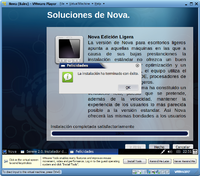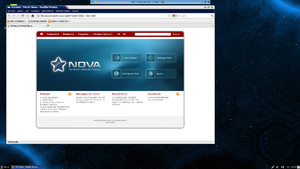COMP 3000 2011 Report: Nova: Difference between revisions
Created page with "== Part I == === Background === Placeholder === Installation/Startup === Placeholder === Basic Operation === Placeholder === Usage Evaluation === Placeholder === Referen…" |
|||
| (7 intermediate revisions by the same user not shown) | |||
| Line 3: | Line 3: | ||
=== Background === | === Background === | ||
Nova (Baire) is a desktop-oriented GNU/Linux distribution aimed at providing Free/Libre/Open Source Software (FLOSS) to inexperienced users and Cuban institutions.[1] It is a state sponsored distribution developed in Havana at the University of Information Science by students and professors. Based initially on Gentoo and Sabayon Linuxes, its base system now is Ubuntu. The goal of Nova is to replace Microsoft Windows as the primary operating system for Cuba. Beginning in 2011, new computers will come installed with both Windows and Nova.[2] There is a link on the official site but at the time it was dead. Alternate links include ones on distrowatch.com, although the speed is slow, and torrent sites; [http://www.linux23.com/torrent/nova-3-gnu-linux-nova-desktop-2011-r1-i386:8e4874e55e5f4a165c7ca45b7d0989dcc2aacbbd this] was a very fast and reliable source as of October 18, 2011. The size of the ISO is approximately 700 MB. | |||
=== Installation/Startup === | === Installation/Startup === | ||
[[File:nova7.png|200px|right|Installation complete.]] | |||
Upon loading the ISO into VMware Player, a desktop is immediately presented with the installation icon. | |||
Step 1: Double click on the “Instalar Nova 2011” icon. | |||
Step 2: Choose the installation language, the only option being Spanish, and your keyboard layout. A box is provided to test the actual keyboard configuration. | |||
Step 3: Select your time zone. | |||
Step 4: Choose how much of the disk will be used in installation. | |||
Step 5: Enter user and computer information. | |||
Step 6: Wait for the installation to complete. | |||
Step 7: Restart the machine. | |||
After that you simply choose the operating system and log in to the account you setup. | |||
=== Basic Operation === | === Basic Operation === | ||
The main problem with this distribution is that Spanish is the only supported language, there may be the option to choose a different one for installation but others have not been added yet. | |||
Upon starting the machine you are presented with the login screen and you are asked to choose a user and enter a password. Once logged in you are sent to the desktop and are shown any messages left for you by other users. Messages can also be left for a user if they lock the screen or the screensaver starts via a button on the log back in prompt. | |||
The desktop is very simple, with the taskbar containing the start menu, clock, recycle bin, volume control, internet control and Empathy, a messaging program. The rest of the screen is the wallpaper and any desktop icons. By default there is the live CD icon for the installation, and an extensive Cuban information guide for the migration to FLOSS. | |||
Within my applications, accessed from the start menu, everything is displayed as icons in groups as opposed to everything being in a menu. Nova (Baire) comes preloaded with all the basic applications: calculator, text editor, games, but also includes easy access to webcams, scanners, the terminal and strangely, an English dictionary. It also comes with Mozilla Firefox and OpenOffice.org. | |||
Audio and video capabilities seem on par with any other operating system, simple games play without difficulty and music plays clearly. Although, this may be due to the VMware player, but the audio lags about a second behind any actions made. Full screen videos however experience severe screen lag, but audio remains unaffected. | |||
=== Usage Evaluation === | === Usage Evaluation === | ||
[[File:nova8.png|300px|right|The Nova (Baire) desktop.]] | |||
Nova (Baire) meets all design goals as a comfortable transition from Microsoft Windows. It is simple enough to attract new users, similar enough that adjustment time is minimal, and provides many features for advanced users. The programs it comes packaged with are easy-to-use and non-redundant. In terms of its design goal, it is a clean and functional distribution. | |||
However, the glaring issue is the lack of additional language support. Having initially been released in 2009, and having been developed for a specific, yet unfulfilled purpose, it appears that the Nova team is focusing on completing the migration of its country's computers. They are also transitioning out of similar Microsoft software such as Explorer and Word, and into open-source software alternatives. | |||
Overall, it is a great distribution, in both appearance and functionality. | |||
=== References === | === References === | ||
1. [http://www.nova.cu/?q=en/who_are_we “Who we are?”] Nova — Distribución Cubana de GNU/Linux. Retrieved 2011-10-18 | |||
2. [http://www.cubastandard.com/2011/02/10/cuba-presents-linux-based-operating-system/ “Cuba presents Linux-based operating system”] Cuba Standard. 2011-2-10. Retrieved 2011-10-18 | |||
== Part II == | == Part II == | ||
== Part III == | == Part III == | ||
Latest revision as of 03:12, 20 October 2011
Part I
Background
Nova (Baire) is a desktop-oriented GNU/Linux distribution aimed at providing Free/Libre/Open Source Software (FLOSS) to inexperienced users and Cuban institutions.[1] It is a state sponsored distribution developed in Havana at the University of Information Science by students and professors. Based initially on Gentoo and Sabayon Linuxes, its base system now is Ubuntu. The goal of Nova is to replace Microsoft Windows as the primary operating system for Cuba. Beginning in 2011, new computers will come installed with both Windows and Nova.[2] There is a link on the official site but at the time it was dead. Alternate links include ones on distrowatch.com, although the speed is slow, and torrent sites; this was a very fast and reliable source as of October 18, 2011. The size of the ISO is approximately 700 MB.
Installation/Startup

Upon loading the ISO into VMware Player, a desktop is immediately presented with the installation icon.
Step 1: Double click on the “Instalar Nova 2011” icon.
Step 2: Choose the installation language, the only option being Spanish, and your keyboard layout. A box is provided to test the actual keyboard configuration.
Step 3: Select your time zone.
Step 4: Choose how much of the disk will be used in installation.
Step 5: Enter user and computer information.
Step 6: Wait for the installation to complete.
Step 7: Restart the machine.
After that you simply choose the operating system and log in to the account you setup.
Basic Operation
The main problem with this distribution is that Spanish is the only supported language, there may be the option to choose a different one for installation but others have not been added yet. Upon starting the machine you are presented with the login screen and you are asked to choose a user and enter a password. Once logged in you are sent to the desktop and are shown any messages left for you by other users. Messages can also be left for a user if they lock the screen or the screensaver starts via a button on the log back in prompt.
The desktop is very simple, with the taskbar containing the start menu, clock, recycle bin, volume control, internet control and Empathy, a messaging program. The rest of the screen is the wallpaper and any desktop icons. By default there is the live CD icon for the installation, and an extensive Cuban information guide for the migration to FLOSS.
Within my applications, accessed from the start menu, everything is displayed as icons in groups as opposed to everything being in a menu. Nova (Baire) comes preloaded with all the basic applications: calculator, text editor, games, but also includes easy access to webcams, scanners, the terminal and strangely, an English dictionary. It also comes with Mozilla Firefox and OpenOffice.org.
Audio and video capabilities seem on par with any other operating system, simple games play without difficulty and music plays clearly. Although, this may be due to the VMware player, but the audio lags about a second behind any actions made. Full screen videos however experience severe screen lag, but audio remains unaffected.
Usage Evaluation

Nova (Baire) meets all design goals as a comfortable transition from Microsoft Windows. It is simple enough to attract new users, similar enough that adjustment time is minimal, and provides many features for advanced users. The programs it comes packaged with are easy-to-use and non-redundant. In terms of its design goal, it is a clean and functional distribution.
However, the glaring issue is the lack of additional language support. Having initially been released in 2009, and having been developed for a specific, yet unfulfilled purpose, it appears that the Nova team is focusing on completing the migration of its country's computers. They are also transitioning out of similar Microsoft software such as Explorer and Word, and into open-source software alternatives.
Overall, it is a great distribution, in both appearance and functionality.
References
1. “Who we are?” Nova — Distribución Cubana de GNU/Linux. Retrieved 2011-10-18
2. “Cuba presents Linux-based operating system” Cuba Standard. 2011-2-10. Retrieved 2011-10-18